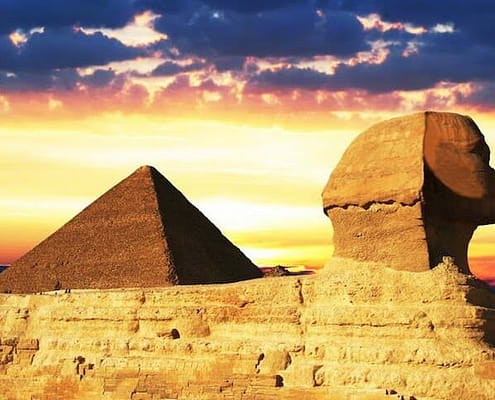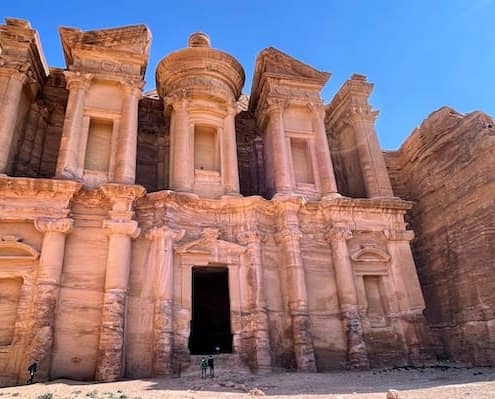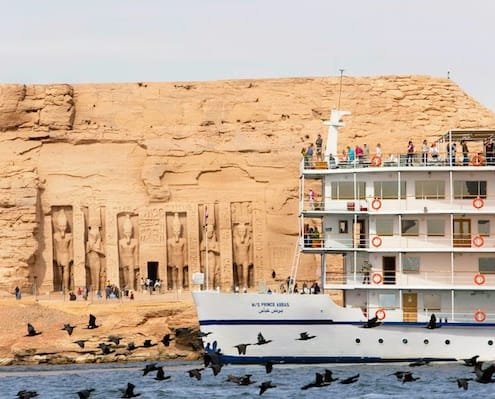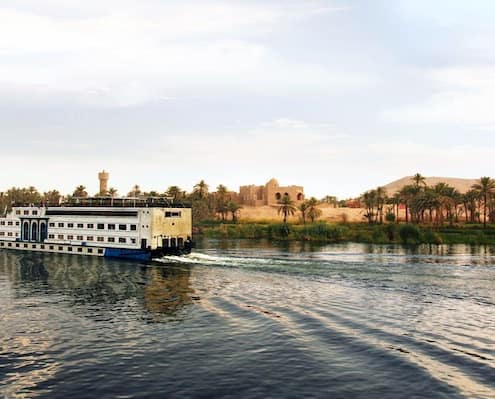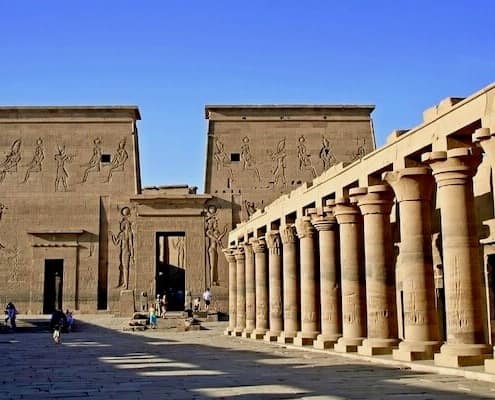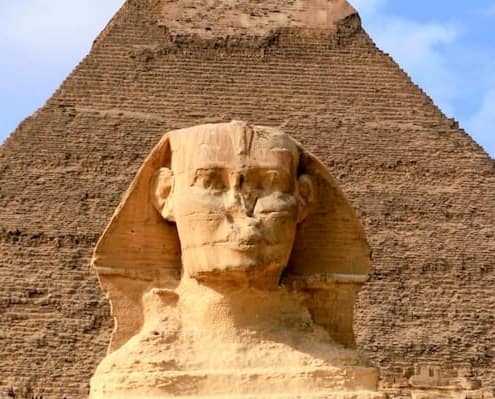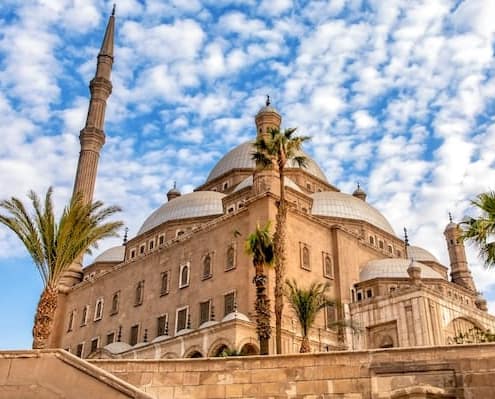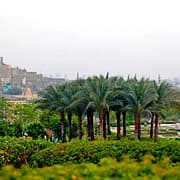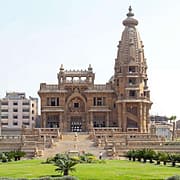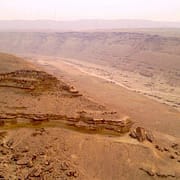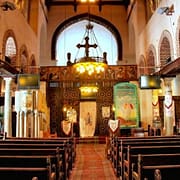Sultan Al-Ghuri Complex – A Reminder of Egypt’s Mamluk Era
For more than 5 centuries, the beautiful Sultan Al-Ghuri Complex has served to remind people of the influence, wealth, and power that Egypt’s Mamluk rulers once enjoyed. This massive complex of Sultan Al-Ghuri straddles al Mu’izz li-Din Allah Street which is most often referred to as Muizz Street. Enjoy a visit and a private tour of the area with one of our flawless Cairo tour packages.
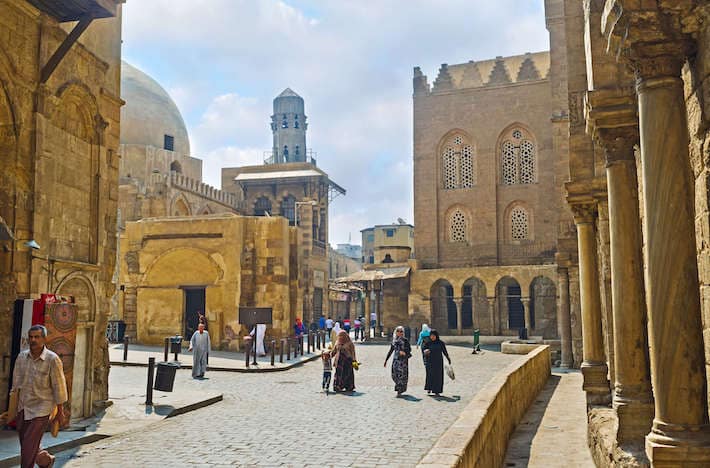
The historic street of Al-Muizz – where Al-Ghuri Complex is located – is a great option for a Cairo walking tour.
Muizz Street is located in Cairo’s old Fahhamin Quarter and is home to many very popular Cairo Tourist Attractions besides the Sultan Al-Ghuri Complex. This makes it one of the most fascinating areas in Cairo, and particularly for people who are interested in old Islamic history and architecture.
The Sultan Al-Ghuri Complex includes a Khanqah; a mausoleum; a sabil; a mosque, and a madrasa. The mosque and madrasa are located on the one side of the road which the complex straddles, while the khanqah, sabil, and mausoleum are located on the other side of the road. A wooden roof installed to provide shade to the street below links the two sides together.
The Sultan Al-Ghuri Complex – A Brief History

Bazaar of the Silk Mercers in Cairo – Drawing of the Al-Ghuri by David Roberts in 1839.
Construction of the Sultan Al-Ghuri Complex began in 1503 and it was completed in 1505. It was commissioned by Sultan Qansuh al-Ghuri, Egypt’s second-last Mamluk sultan. Qansuh al-Ghuri ruled from 1501 to 1516, and he was the last sultan to rule for such a lengthily time.
Qansuh al-Ghuri served as the governor of Tarsus, and later went on to be the chamberlain of Aleppo. He was well known for the role he played during the war with the Ottomans, a military campaign in which he was heavily involved.
Sadly, Qansuh al-Ghuri suffered a fatal heart attack at the age of 75 while fighting outside Aleppo against the Ottoman Turks. The Sultan’s body was never found, and as a result, he could not be laid to rest inside the very costly mausoleum which he had built at the Sultan Al-Ghuri Complex.
During his life, Al-Ghuri was known to be a very energetic, with some reports stating that he was still playing polo regularly at the age of 70.
On one hand, Sultan Al-Ghuri was a man of refinement who enjoyed many gentle things in life, including flowers, music, poetry, and architecture.
On the other hand, he was known as a cruel and very superstitious despot ruler who would dish out exceedingly harsh punishments for crimes committed, whether real or only imagined.
The Overall Layout of the Sultan Al-Ghuri Complex
The Sultan Al-Ghuri funerary complex essential consists of two blocks that straddle Muizz Street which runs through the heart of Cairo’s medieval district. The western block consists of a mosque with a minaret, and in its heyday, this part of the complex would also have served as a madrasa (school). The eastern block is a funerary complex consisting of a mausoleum, a sabil, a khanqah, and a small graveyard.
The Mosque
The mosque at the Sultan Al-Ghuri Complex is by no means as impressive as some of Cairo’s other old mosques, and especially the old Fatimid-era mosques. However, it is still a lovely place to visit, and it does have some wonderful features, including the abundant use of white and black marble. Its solitary minaret which is four stories high is also a very notable feature. It was the very first minaret with a square upper section to be built in Egypt.
The Mausoleum, Khanqah and Sabil
The mausoleum is quite an elaborate one which the sultan had built at great expense. It was built to house the sultan’s remains following his death, but he died on the battlefield and his body was never recovered. The mausoleum area once also had an impressive brick-made dome which was covered entirely with green tiles, but unfortunately this has since collapsed.
The Khanqah at this complex is also rather unique, in that there are no living quarters attached to them. Records do however show that Sufis did in fact have meetings there. With the absence of attached living quarters, it can only be assumed that visiting Sufis and others would have had to stay in the few living quarters found across the street at the madrasa.
The sabil, which was essentially an area where water was dispensed freely to the public, has a striking polychrome marble pavement. It is considered to be the most elaborate of its kind in Cairo, and features a densely packed collection of geometric stars, each with 20 points.
Visiting Al-Ghuri Complex and Muizz Street
The Sultan Al-Ghuri Complex is a huge monument; it’s a beautiful monument, and it certainly represents a very significant era in Egypt’s fascinating history. It was, after all, built by the country’s second-last Mamluk Sultan. It is also conveniently located in a part of Cairo which is home to several other wonderful attractions.
As with so many other attractions in Cairo, you will enjoy a visit to the Sultan Al-Ghuri Complex so much more if you are accompanied by a professional guide, than you will if you visit the site on your own. The good news is that if you book any Cairo Tour Packages through Egypt Tours Plus, you will always have one of our exceptionally knowledgeable guides by your side to answer questions and to explain the history of the various sites you visit.
If you are contemplating booking one of our Egypt tour Packages, and you would like to visit this particular attraction, it is highly recommended that you check your preferred tour itinerary carefully before booking to see if this attraction is included or not.
If it is not included, and you would like it to be, simply let us know and we will add it to your chosen itinerary. After All, at Egypt Tours Plus, all tours can be customized and tailored to meet the exact needs of our clients.
Design Your Custom Egypt Tour
Explore Egypt your way by selecting only the attractions you want to visit
Egypt Travel Information
Last Updated on April 20, 2025


